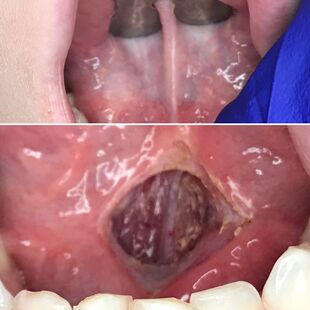Medicine:Frenectomy
| Frenectomy | |
|---|---|
 Lingual frenectomy performed on a 5-year-old boy using a LightScalpel 10,600 nm CO2 laser. The photos show the frenum under the tongue immediately before the procedure and the surgical site immediately after. | |
| Other names | frenulectomy or frenotomy) |
A frenectomy is the removal of a frenulum, a small fold of tissue that prevents an organ in the body from moving too far. It can refer to frenula in several places on the human body. It is related to frenuloplasty, a surgical alteration in a frenulum. Done mostly for orthodontic purposes, a frenectomy is either performed inside the middle of the upper lip, which is called labial frenectomy, or under the tongue, called lingual frenectomy. Frenectomy is a very common dental procedure that is performed on infants, children, and adults. A similar procedure frenulotomy is where a tight frenulum may be relieved by making an incision in the tight tissue.
Types
There are several frenula that are associated with types of frenectomy:[citation needed]
- Genital frenectomy can be performed to remove frenulums from genitalia
- Lingual frenectomy (of the tongue) as a treatment for ankyloglossia (tongue-tie)
- Labial frenectomy (of the lip) is very common with patients undergoing denture treatment to get the proper fit of dentures or patients who have tissues attached to center of the upper lip and causing recession of gums or gap between the upper front teeth called central incisors.
- A frenectomy can also be performed to remove a section of tissue (the frenulum) that attached to the gingival tissue between two teeth.
Pediatric and infant frenectomies
In the past, the frenectomy procedure was perhaps the most popular of soft tissue operations in younger patients. Many labial and lingual frenum (tongue- and lip-ties) were snipped by a midwife, family doctor or dental surgeon.[1] The overall awareness and treatment of tongue- and lip-ties especially in breastfeeding infants has increased over recent years.[2] Frenectomies are routinely performed on infants to improve breastfeeding outcomes.[3]
In 2020, medical professionals raised the concern that a recent rise in unnecessary frenectomies on infants may be encouraged in part by information shared in online parenting groups. While public healthcare options (e.g. NHS) may not cover frenulectomies, in part due to these concerns, private clinic surgeries remain viable options for concerned parents.[4]
Traditionally tongue-ties are diagnosed by appearance alone; newer research advocates for a functional assessment to determine any deleterious effect on breastfeeding. Before any surgical intervention for difficulties related to breastfeeding, preoperative consultation with a certified lactation consultant is recommended.[5]
Laser frenectomy with CO2 surgical lasers
Frenectomies can be safely and efficiently released with the soft tissue 10,600 nm CO2 laser with predictable and repeatable tissue response, fast ablation and instant hemostasis.[6] The extremely precise cutting, minimal collateral damage, clear and bloodless operating field, make the CO2 laser a good choice for frenectomy procedures.[7][8] CO2 laser oral surgery also features less wound contraction and reduced scarring or fibrosis in comparison with scalpel incisions.[9]
References
- ↑ Archer, WH (1952). Oral and Maxillofacial Surgery. W.B. Saunders Co. pp. 407.
- ↑ Baxter, Richard; Musso, Megan; Hughes, Lauren; Lahey, Lisa; Fabbie, Paula; Lovvorn, Marty; Emanuel, Michelle; Agarwal, Rajeev (2018). Tongue-Tied: How a Tiny String Under the Tongue Impacts Nursing, Speech, Feeding, and More. United States: Alabama Tongue-Tie Center. pp. 19–34. ISBN 978-1-7325082-0-0. https://books.google.com/books?id=95c4uQEACAAJ.
- ↑ Ghaheri, Bobak A.; Cole, Melissa; Fausel, Sarah C.; Chuop, Maria; Mace, Jess C. (2017). "Breastfeeding improvement following tongue-tie and lip-tie release: A prospective cohort study" (in en). The Laryngoscope 127 (5): 1217–1223. doi:10.1002/lary.26306. ISSN 1531-4995. PMID 27641715.
- ↑ Fraser, Lyndsay; Benzie, Stuart; Montgomery, Jenny (2 October 2020). "Posterior tongue tie: the internet phenomenon driving a lucrative private industry". The BMJ. https://blogs.bmj.com/bmj/2020/10/02/posterior-tongue-tie-the-internet-phenomenon-driving-a-lucrative-private-industry/.
- ↑ Merkel-Walsh, Robyn; Gatto, Kristie (2021). "The Team Approach in Treating Oral Sensory-Motor Dysfunction in Newborns, Infants and Babies with a Diagnosis of Tethered Oral Tissue". Journal of the American Laser Study Club 4 (1): 28–45. ISSN 2576-7852. https://www.americanlaserstudyclub.org/purchase/jalsc-infant-laser-frenectomy/.
- ↑ Riek, C; Vitruk, P (Spring 2018). "Incision and Coagulation/Hemostasis Depth Control During a CO2 Laser Lingual Frenectomy". Dental Sleep Practice (MedMark): 32–38. https://dentalsleeppractice.com/ce-focus/incision-coagulation-hemostasis-depth-control-co2-laser-lingual-frenectomy/.
- ↑ Chiniforush, Nasim; Ghadimi, Sara; Yarahmadi, Nazli; Kamali, Abbas (2013). "Treatment of Ankyloglossia with Carbon Dioxide (CO2) Laser in a Pediatric Patient". Journal of Lasers in Medical Sciences 4 (1): 53–55. ISSN 2008-9783. PMID 25606307.
- ↑ Fiorotti, Renata C.; Bellini, Bruno S.; Cassitas, Nilceu P.; Baldin, Diva H. Z.; Nicola, Ester M. D. (2000). "Use of CO 2 laser in lingual and labial frenectomy". in Featherstone, John D. B; Rechmann, Peter; Fried, Daniel. Use of CO2 laser in lingual and labial frenectomy. Lasers in Dentistry VI. 3910. pp. 117–123. doi:10.1117/12.380818. http://repositorio.unicamp.br/jspui/handle/REPOSIP/107345.
- ↑ Zeinoun, T.; Nammour, S.; Dourov, N.; Aftimos, G.; Luomanen, M. (2001). "Myofibroblasts in healing laser excision wounds". Lasers in Surgery and Medicine 28 (1): 74–79. doi:10.1002/1096-9101(2001)28:1<74::aid-lsm1019>3.3.co;2-2. ISSN 0196-8092. PMID 11430446.
Further reading
 |

